Samaritan is a proud provider of Dementia Care and uniquely distinguished as a GUIDE provider by the Centers for Medicare and Medicaid (CMS). Click to learn more.
(856) 596-1600 available 24/7 Refer Now

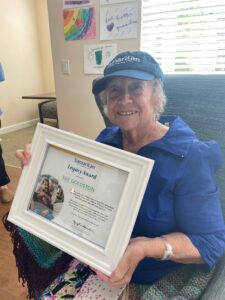
In Loving Memory of Sue
Sue Goldstein learned about the importance of comfort at the end of life as a nurse in a New York City hospital in the 1970s. Her experiences would significantly benefit thousands of families in Southern New Jersey as she went on to become a hospice volunteer. Her steadfast volunteer service ultimately paved the way for the care she would need later in life.
Sue Goldstein became a revolutionary volunteer of Hospice of Burlington County in 1982 and would eventually contribute thousands of hours of volunteer service over the course of two decades.
“Sue is an unsung hero of Samaritan,” said Clark Dingman, Samaritan’s first president and CEO. “She knew the importance of hospice [before many others] and was a vital Samaritan ambassador.”
In 1982, Hospice of Burlington County, now known as Samaritan, was in its second year of service and just incorporated into a community-based not-for profit. The organization was looking for a core of dedicated volunteers to help further its mission of service so they placed an “Interested in volunteering?” ad in the Burlington County Times. Sue answered the call.
After being a nurse in New York City, she knew the importance of comfort, support, and dignity at the end of life. She worked the 4 p.m. to midnight shift in a hospital, and one night a meaningful yet heart-breaking experience with a patient would change her overall outlook on health care.
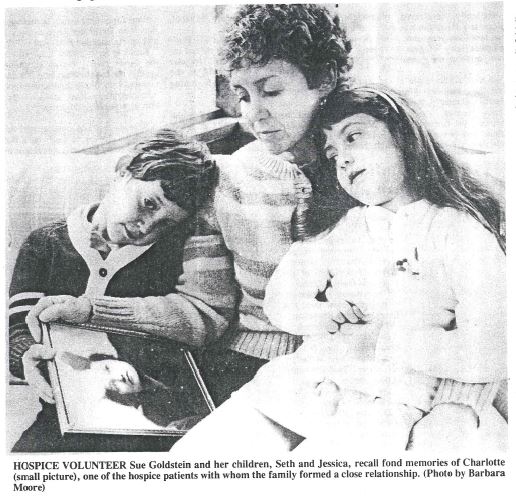
“No one should have to die alone in the hospital,” she said. Her patient was an 18-year-old man with an extremely high fever, Leukemia, and no visitors. Without family or friends by his side, Sue spent most of her shift sitting with him, holding his hand, and comforting him until he died. Moved by the encounter, Sue knew that no one deserved to be alone at the end of life.
This experience would serve as the inspiration for her significant contributions to hospice. Through volunteerism, she would go on to educate hundreds of people in the South Jersey community about the benefits of hospice care. She would also raise hundreds of thousands of dollars for patients and their families at a time when there was no Medicare, Medicaid reimbursement, or private insurance to cover the cost.
Clark said of Sue, “Her early commitment and enthusiasm to ensure that everyone received hospice care, regardless of their ability to pay, was infectious.”
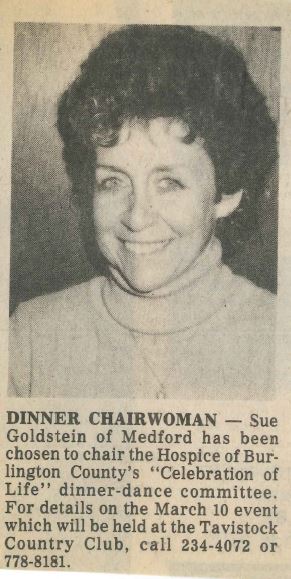 Before serving as that dedicated community ambassador, a role that would cement her legacy, Sue originally signed up to be a patient support volunteer. A patient support volunteer offers companionship to families in the form of chatting, watching TV, playing games, and reading. Read 1984 Central Record article about patient volunteering.
Before serving as that dedicated community ambassador, a role that would cement her legacy, Sue originally signed up to be a patient support volunteer. A patient support volunteer offers companionship to families in the form of chatting, watching TV, playing games, and reading. Read 1984 Central Record article about patient volunteering.
She fondly recalled one of the first patients she visited. Sofia* was an Italian woman who lived alone. Sue and Sophia would sit for hours chatting and sharing stories. During some visits, Sue would even bring her five-year-old daughter, Jessica, and seven-year-old son, Seth. The children would spread out their crayons and, together with Sophia, fill the pages of coloring books with cheerful yellows, oranges, and pinks. That Christmas, Sofia – despite painful arthritis in her hands – knitted scarves and mittens for Sue’s children. “I was so touched that she appreciated me and my family. We made many special memories while visiting her,” said Sue.
Sue’s volunteer course changed from visiting patients and families to fundraising after she attended Hospice of Burlington County’s Dinner Dance, an annual fund- and friend-raising celebration to benefit hospice patients. During a conversation with Clark about the goals and success of the dance, Sue commented, “We can do better.” Clark appreciated her eagerness and asked, “Do you want to chair the next Dinner Dance?” Like she did with the volunteer ad, Sue answered the call with a resounding yes and served as Dinner Dance chair from 1983 to 1993.
Clark added, “Sue was always a rock of inspiration and support. Her commitment [to the mission] built the foundation of what Samaritan is today.”
In those first years, Sue called on key contacts and organizations in the community to ask for their financial support. Unfortunately, each time she asked if they knew about hospice care and if they would be interested in supporting the cause, many politely replied, “No, thank you.”
In the early 1980s, the community had never heard of hospice care even though hospice started to grow as a form of care in the United States during the 1960s thanks to Dame Cecily Saunders and Elisabeth Kubler-Ross. By the early 1980s, it was also pioneered nationally through the National Hospice Organization, the creation of the Medicare Hospice Benefit and The Joint Commission Hospice Accreditation Program.
Yet, Sue still had a lot of work to do to reach the South Jersey community.
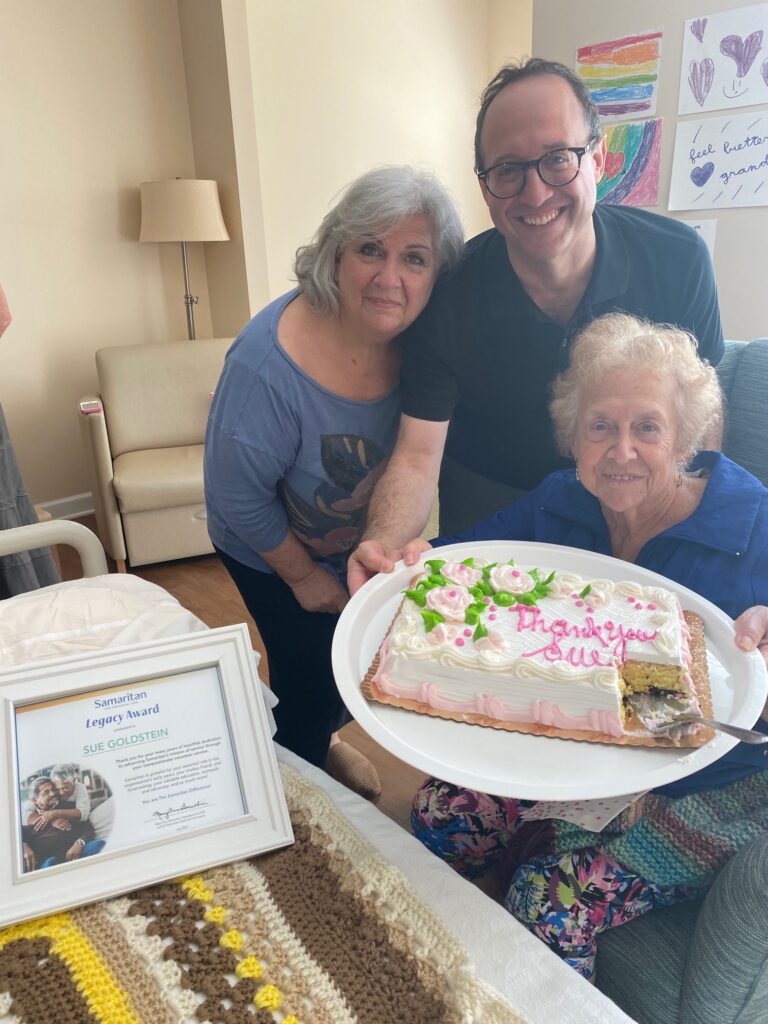
“As people continually turned me down, I started to take it personally. However, I ultimately decided to persevere. I returned for repeat visits, continued to educate, continued to explain the benefits of hospice, and told them, ‘We need you and your help.’”
Because of Sue’s determination, the benefits of hospice care started spreading throughout the community and donations increased. To extend her reach and maximize funds, she eventually needed help. That’s when she formed the Women’s Auxiliary, a group of women dedicated to fundraising. Clark said, “Sue did a phenomenal job motivating people to reach out to the family, friends, and colleagues in their address books.”
Year after year, Sue continued to repeat her well-rehearsed script about the benefits of hospice care, successfully reaching more people, and raising more funds for the not-for-profit mission.
Samaritan’s census increased from 81 patients in 1980 to 229 patients in 1984. The census would continue to grow to 1,480 patients in 1994 thanks to Sue’s dedication. She helped raise more than $750,000 for patients and their families during that time.
She said, “I definitely got way more in return [from my volunteer service] than I ever gave.”
By 1994, Samaritan realized the value of marketing and development and decided to hire its first director of marketing. Joanne Rosen fulfilled that role and currently serves as chief marketing and public affairs. Just like Sue, Joanne works with an unwavering passion and dedication for the organization and its mission. However, with this new position, it changed Sue’s volunteer focus from marketing and fundraising to board member.
“We are all standing on the shoulders of those who came before us. Sue’s energy and passion really inspired me. I felt responsible to help continue what she had started to advance Samaritan’s mission,” said Joanne.
“I’m very proud of the work I did to help Hospice,” said Sue as she rested comfortably at home after a short stay at The Samaritan Center at Voorhees.
Sue, now 75 and living with cardiomyopathy (heart muscle disease), experienced a significant health decline in recent months. She felt frustrated and depressed. She lived by herself, many miles from her children, and began having difficulty caring for herself and managing her household. She didn’t know what to do.
“I was at my wits end. I was independent for so long, but then I started feeling so awful. I went from doctor to doctor. I was getting worse. They said there was no surgery they could do that I would live through. That’s when I decided to contact Samaritan.”
Specifically, after 20 years, Sue reached out to Joanne Rosen, who – just like Sue did forty years earlier – answered the call for help.
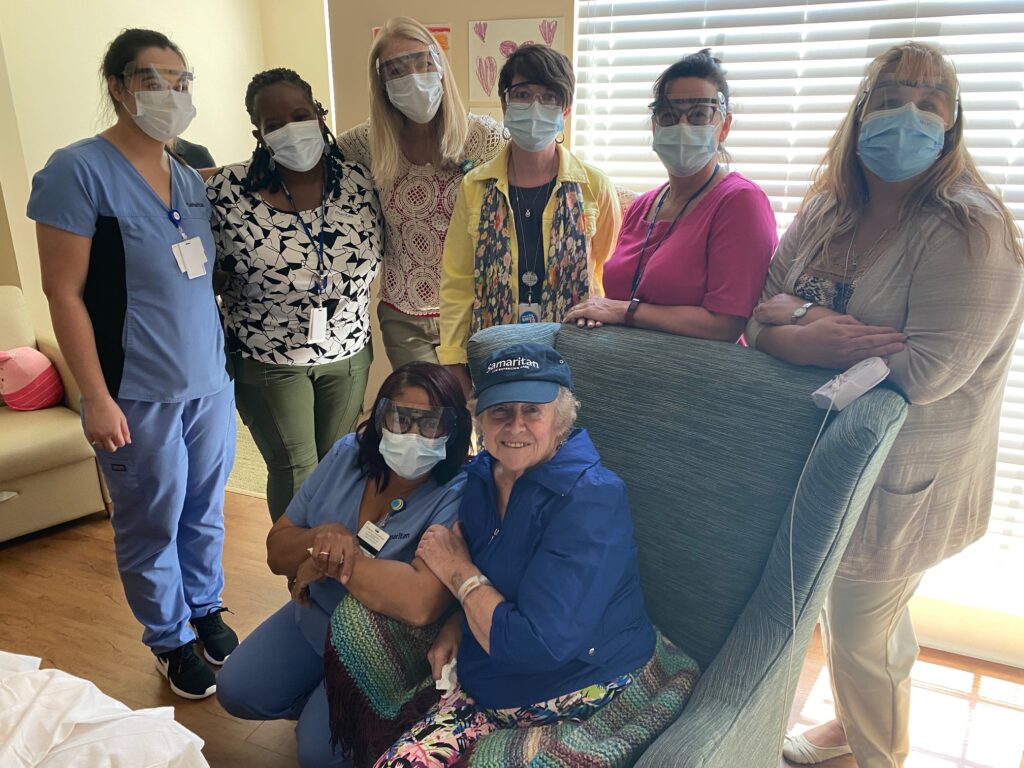
“I called Joanne in tears,” said Sue. “I explained my situation, my fears, my pain. She listened and never rushed me through my story. When I was finished she said, ‘Ok, let me see what I can do.’ Then we hung up.”
“Joanne called me back within one hour with a plan of care to get me help. It was amazing.”
Joanne adds, “When I heard Sue’s voice, I was delighted and concerned at the same time. My dear old friend was calling, but she sounded weak and needed help. I was so glad that she reached out and that our team responded right away.”
Sue continues, “Once Samaritan got involved, the team made sure I didn’t have to worry about a thing. The nurse got my pain under control. I also talked with a social worker about all my fears, anxiety, and depression. The hospice team has been incredible. I couldn’t be more proud of having been a part of Samaritan.”
Sue’s life has now come full circle.
Thanks to her early pioneering, Samaritan’s hospice team provides her the care she needs at the end of her life. In addition, because of Sue’s hard work and dedication, she laid the groundwork for anyone in the community to access this important care regardless of their ability to pay.
Samaritan President and CEO Mary Ann Boccolini adds, “Sue shared the same heart and soulful insight as other women pioneers of the hospice movement: You matter because you are you, and you matter to the end of your life. She knew that through our kindness, our willingness to listen, and our ability to communicate honestly and empathetically that we can change the quality of life for those experiencing serious illness. We are thankful for Sue’s tremendous advocacy and support throughout the years. It is with respect and gratitude that I say on behalf of Samaritan, ‘You matter, Sue!’”
*Name changed.